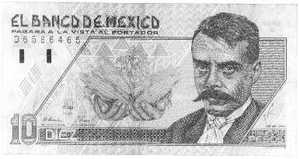 Zapata, Emiliano (1877?-1919), Mexican revolutionary leader and
agrarian reformer, born in San Miguel Anenecuilco in Morelos
State. An illiterate tenant farmer of almost pure Indian blood,
he recruited an army of Indians from villages and haciendas in
Morelos and, under the rallying cry Land and Liberty, joined the
Mexican revolutionist Francisco Madero in the 1910 revolt against
the Mexican soldier-statesman Porfirio DÃaz. Having lost
faith in Madero, who assumed the presidency in 1911, Zapata
formulated his agrarian reform plan; known as the Plan of Ayala,
it called for the land to be redistributed among the Indians.
During the provisional presidencies of the Mexican
soldier-politician Victoriano Huerta and, later, the Mexican
statesman Venustiano Carranza, Zapata continued his resistance to
the government. By this time Zapata had extended his power
throughout southern Mexico. With the Mexican revolutionary
general Francisco Villa, Zapata marched on Mexico City, entering
it the first of three times in 1914. The following year Zapata
withdrew to Morelos where, still resisting, he later was murdered
by an agent of Carranza.
Although regarded as merely a pillaging bandit by his
enemies, Zapata was idolized by the Indians as the true
revolutionary reformer and hero; his life has inspired countless
legends and ballads.
Zapata, Emiliano (1877?-1919), Mexican revolutionary leader and
agrarian reformer, born in San Miguel Anenecuilco in Morelos
State. An illiterate tenant farmer of almost pure Indian blood,
he recruited an army of Indians from villages and haciendas in
Morelos and, under the rallying cry Land and Liberty, joined the
Mexican revolutionist Francisco Madero in the 1910 revolt against
the Mexican soldier-statesman Porfirio DÃaz. Having lost
faith in Madero, who assumed the presidency in 1911, Zapata
formulated his agrarian reform plan; known as the Plan of Ayala,
it called for the land to be redistributed among the Indians.
During the provisional presidencies of the Mexican
soldier-politician Victoriano Huerta and, later, the Mexican
statesman Venustiano Carranza, Zapata continued his resistance to
the government. By this time Zapata had extended his power
throughout southern Mexico. With the Mexican revolutionary
general Francisco Villa, Zapata marched on Mexico City, entering
it the first of three times in 1914. The following year Zapata
withdrew to Morelos where, still resisting, he later was murdered
by an agent of Carranza.
Although regarded as merely a pillaging bandit by his
enemies, Zapata was idolized by the Indians as the true
revolutionary reformer and hero; his life has inspired countless
legends and ballads.
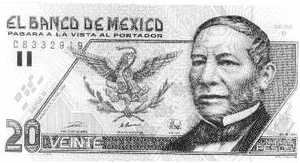 Juarez, Benito Pablo (1806-72), national hero and president of
Mexico (1861-63 and 1867-72). Juarez was born of Indian parents
on March 21, 1806, near the town of Oaxaca. Educated in law,
Juarez became (1847) governor of the state of Oaxaca and was
imprisoned when the Mexican general Antonio de Santa Anna seized
(1853) the national government. He escaped to New Orleans,
Louisiana, but returned to Mexico in 1855 to take part in the
revolution that overthrew Santa Anna. Juarez became minister of
justice in the new government and instituted a series of liberal
reforms that were embodied in the constitution of 1857.
The following year Juarez became provisional president after
the outbreak of a revolt led by conservative elements. Soon
afterward he was forced to flee the national capital, Mexico
City, and established a new seat of government at Veracruz. He
initiated a number of sweeping reforms, including the reduction
of the civil power of the Roman Catholic church by confiscating
ecclesiastical property. He defeated the conservative forces in
1860 and 1861, when he established his government in Mexico City
and was constitutionally elected president.
Facing financial chaos caused by five years of civil war,
Juarez suspended payments to foreign creditors in 1861. France,
Spain, and Great Britain intervened, however, and landed troops
at Veracruz. Juarez reached a settlement with Great Britain and
Spain; those countries withdrew from Mexico, but the French
remained and captured Mexico City. Maximilian, archduke of
Austria, the puppet of Emperor Napoleon III of France, was
crowned emperor of Mexico in 1864. Juarez moved his capital to
the north and continued military resistance. When Maximilian's
government fell in 1867, Juarez returned to Mexico City and was
reelected president. In 1871 the statesman Porfirio DÃaz, an
unsuccessful political candidate against Juarez, began a revolt
that eventually was quelled, but Juarez died of apoplexy on July
18, 1872, in Mexico City, before the end of the uprising. He is
regarded as one of the greatest heroes in Mexican
history.
Juarez, Benito Pablo (1806-72), national hero and president of
Mexico (1861-63 and 1867-72). Juarez was born of Indian parents
on March 21, 1806, near the town of Oaxaca. Educated in law,
Juarez became (1847) governor of the state of Oaxaca and was
imprisoned when the Mexican general Antonio de Santa Anna seized
(1853) the national government. He escaped to New Orleans,
Louisiana, but returned to Mexico in 1855 to take part in the
revolution that overthrew Santa Anna. Juarez became minister of
justice in the new government and instituted a series of liberal
reforms that were embodied in the constitution of 1857.
The following year Juarez became provisional president after
the outbreak of a revolt led by conservative elements. Soon
afterward he was forced to flee the national capital, Mexico
City, and established a new seat of government at Veracruz. He
initiated a number of sweeping reforms, including the reduction
of the civil power of the Roman Catholic church by confiscating
ecclesiastical property. He defeated the conservative forces in
1860 and 1861, when he established his government in Mexico City
and was constitutionally elected president.
Facing financial chaos caused by five years of civil war,
Juarez suspended payments to foreign creditors in 1861. France,
Spain, and Great Britain intervened, however, and landed troops
at Veracruz. Juarez reached a settlement with Great Britain and
Spain; those countries withdrew from Mexico, but the French
remained and captured Mexico City. Maximilian, archduke of
Austria, the puppet of Emperor Napoleon III of France, was
crowned emperor of Mexico in 1864. Juarez moved his capital to
the north and continued military resistance. When Maximilian's
government fell in 1867, Juarez returned to Mexico City and was
reelected president. In 1871 the statesman Porfirio DÃaz, an
unsuccessful political candidate against Juarez, began a revolt
that eventually was quelled, but Juarez died of apoplexy on July
18, 1872, in Mexico City, before the end of the uprising. He is
regarded as one of the greatest heroes in Mexican
history.
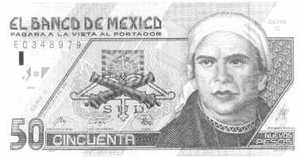 Morelos y Pavón, José MarÃa (1765-1815), Mexican
priest, who led the independence movement after the execution of
Miguel Hidalgo y Costilla. He was born in present-day Morelia,
Michoacán, and educated there. Ordained in 1797, he was a
parish priest until he joined Hidalgo's rebellion in 1810. Given
a military commission, he soon gained control of a wide territory
in central Mexico; by late 1811 he was generally recognized as
the leader of the rebellion. He captured Acapulco in 1813 and
later that year sponsored the Congress of Chilpancingo, which
issued a declaration of independence, promulgated a constitution,
and appointed Morelos generalissimo of the insurgent government.
After a defeat of his army in December 1813, however, Morelos
fought a defensive war. He was captured by royalist forces in
November 1815, while protecting the Congress on a march to
safety. Convicted of heresy and defrocked by the Inquisition, he
was then turned over to secular authorities and executed.
Morelos y Pavón, José MarÃa (1765-1815), Mexican
priest, who led the independence movement after the execution of
Miguel Hidalgo y Costilla. He was born in present-day Morelia,
Michoacán, and educated there. Ordained in 1797, he was a
parish priest until he joined Hidalgo's rebellion in 1810. Given
a military commission, he soon gained control of a wide territory
in central Mexico; by late 1811 he was generally recognized as
the leader of the rebellion. He captured Acapulco in 1813 and
later that year sponsored the Congress of Chilpancingo, which
issued a declaration of independence, promulgated a constitution,
and appointed Morelos generalissimo of the insurgent government.
After a defeat of his army in December 1813, however, Morelos
fought a defensive war. He was captured by royalist forces in
November 1815, while protecting the Congress on a march to
safety. Convicted of heresy and defrocked by the Inquisition, he
was then turned over to secular authorities and executed.
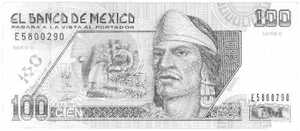 Nezahualcoyote was the son of Ixtlilxóchitl, the ruler of
Texcoco from 1409 until 1418. Defeated in battle by
Tezozómoc, Ixtlilxóchitl retreated to a remote spot
where he faced his pursuers alone. After a valiant struggle, he
was impaled on the spears of his enemies in full view of his
young son, Nezahualcoyote (Fasting Coyote), who was concealed in
a tree. This heir to the throne of Texcoco managed to escape the
henchmen of Tezozómoc and finally found sanctuary across the
mountains to the east. "In order to wipe out the memory of
Ixtlilxóchitl," writes Frederick Peterson, "Tezozómoc
had his soldiers ask every child in Texcoco under the age of
seven, 'Who is your king?' When the little children answered
either 'Ixtlilxóchitl' or 'Nezahualcoyote,' they were
immediately struck down with obsidian-edged clubs. In this way
several thousand children were put to death before parents taught
their children the name of Tezozómoc. Two years later, in
1420, at the age of one hundred, Tezozómoc finally
relinquished his rule. Nezahualcoyote came to rule the city of
Texcoco from 1418 until 1472. To a considerable extent Texcoco's
strength was owing to the brilliance of Nezahualcoyote. While so
many are remembered for their military exploits, the illustrious
Nezahualcoyote is recalled for his cultural refinement. He was
too much a man of his times to be a pacifist, and he steadily
increased his influence through military force, but he had more
positive redeeming qualities. Renowned for his philosophical
verse, this "Poet King of Texcoco" was also a wise legislator and
an impartial judge; he did not hesitate to condemn to death, for
example, members of his own family who broke laws. In addition he
was an engineer who was instrumental in the construction of a
great aqueduct, which brought water to Tenochititlán from
the mainland, and of a long dike across the lake. A scholar and
bibliophile, his Texcoco, "the Athens of Anáhuac," had
libraries housing thousands of manuscripts, which were,
tragically, later destroyed. The city, with its gardens, royal
baths, and beautiful temples, was the finest expression of
civilization in an age otherwise marred by cruelty, intrigue, and
almost constant warfare. When Nezahualcoyote died in 1472, his
son Nezahualpilli, who had many of his father's qualities, became
ruler of Texcoco, but the city came increasingly under the
influence of Tenochititlán."
Nezahualcoyote was the son of Ixtlilxóchitl, the ruler of
Texcoco from 1409 until 1418. Defeated in battle by
Tezozómoc, Ixtlilxóchitl retreated to a remote spot
where he faced his pursuers alone. After a valiant struggle, he
was impaled on the spears of his enemies in full view of his
young son, Nezahualcoyote (Fasting Coyote), who was concealed in
a tree. This heir to the throne of Texcoco managed to escape the
henchmen of Tezozómoc and finally found sanctuary across the
mountains to the east. "In order to wipe out the memory of
Ixtlilxóchitl," writes Frederick Peterson, "Tezozómoc
had his soldiers ask every child in Texcoco under the age of
seven, 'Who is your king?' When the little children answered
either 'Ixtlilxóchitl' or 'Nezahualcoyote,' they were
immediately struck down with obsidian-edged clubs. In this way
several thousand children were put to death before parents taught
their children the name of Tezozómoc. Two years later, in
1420, at the age of one hundred, Tezozómoc finally
relinquished his rule. Nezahualcoyote came to rule the city of
Texcoco from 1418 until 1472. To a considerable extent Texcoco's
strength was owing to the brilliance of Nezahualcoyote. While so
many are remembered for their military exploits, the illustrious
Nezahualcoyote is recalled for his cultural refinement. He was
too much a man of his times to be a pacifist, and he steadily
increased his influence through military force, but he had more
positive redeeming qualities. Renowned for his philosophical
verse, this "Poet King of Texcoco" was also a wise legislator and
an impartial judge; he did not hesitate to condemn to death, for
example, members of his own family who broke laws. In addition he
was an engineer who was instrumental in the construction of a
great aqueduct, which brought water to Tenochititlán from
the mainland, and of a long dike across the lake. A scholar and
bibliophile, his Texcoco, "the Athens of Anáhuac," had
libraries housing thousands of manuscripts, which were,
tragically, later destroyed. The city, with its gardens, royal
baths, and beautiful temples, was the finest expression of
civilization in an age otherwise marred by cruelty, intrigue, and
almost constant warfare. When Nezahualcoyote died in 1472, his
son Nezahualpilli, who had many of his father's qualities, became
ruler of Texcoco, but the city came increasingly under the
influence of Tenochititlán."
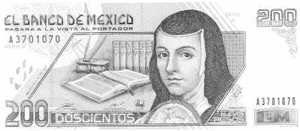 Juana Inès de La Cruz (1651-95), Mexican poet and scholar,
whose ingenious, eloquent, and expressive verse has earned her a
place as the outstanding 17th-century poet of Spanish America.
She was born in San Miguel and largely self-educated. A prodigy
in her childhood, she learned to read at the age of three. In her
teens, she served as a lady-in-waiting at the court of the
viceroy of New Spain and was renowned for her beauty, wit,
intelligence, and learning. After several years, she retired from
court life to become a nun. Some biographers have attributed her
retirement to an unhappy love affair, but she declared that only
the monastic life permitted her sufficient opportunity to carry
on her intellectual pursuits.
As a nun, Juana de la Cruz studied theology, literature,
history, music, and science. She corresponded with many leading
poets and scholars of her day and wrote poetry that earned her
the sobriquet the Tenth Muse. In response to a reprimand from a
superior, she wrote a letter defending her secular interests and
pleading for equal educational opportunities for women. Two years
before her death, she gave up her studies and turned almost
wholly to religious contemplation. Her writings, comprising lyric
and allegorical poems and religious and secular drama, were
published in Spain between 1689 and 1700.
Juana Inès de La Cruz (1651-95), Mexican poet and scholar,
whose ingenious, eloquent, and expressive verse has earned her a
place as the outstanding 17th-century poet of Spanish America.
She was born in San Miguel and largely self-educated. A prodigy
in her childhood, she learned to read at the age of three. In her
teens, she served as a lady-in-waiting at the court of the
viceroy of New Spain and was renowned for her beauty, wit,
intelligence, and learning. After several years, she retired from
court life to become a nun. Some biographers have attributed her
retirement to an unhappy love affair, but she declared that only
the monastic life permitted her sufficient opportunity to carry
on her intellectual pursuits.
As a nun, Juana de la Cruz studied theology, literature,
history, music, and science. She corresponded with many leading
poets and scholars of her day and wrote poetry that earned her
the sobriquet the Tenth Muse. In response to a reprimand from a
superior, she wrote a letter defending her secular interests and
pleading for equal educational opportunities for women. Two years
before her death, she gave up her studies and turned almost
wholly to religious contemplation. Her writings, comprising lyric
and allegorical poems and religious and secular drama, were
published in Spain between 1689 and 1700.
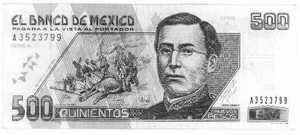 Ignacio Zaragoza was the Mexican general commanding the Mexican
troops in the battle against the French at the town of Puebla.
Shortly after the Spanish and British troops withdrew their
armies from Mexico, the French army, reinforced with an
additional forth-five hundred troops, began to march inland on
its war of occupation. the French minister in Mexico City
informed the invading commander that the French would be welcomed
with open arms in Puebla, and that the local clergy would not
only shower them with magnolia blooms but would offer a special
Te Deum in their honor. But Puebla, although conservative and pro
clerical, was not to be such an easy prize. Encountering
unexpected opposition on the morning of May 5, 1862, the French
attacked recklessly, and with two hours the French had expended
half of their ammunition. The French troops, many weakened by the
affliction that sometimes smites the foreign visitor to the
Mexican countryside, did not acquit themselves well. General
Zaragoza, on the other hand, managed his troops with rare aplomb.
The decisive maneuver of the day was carried out by young
Brigadier General Porfirio DÃaz, commanding the Second
Brigade. Late in the afternoon DÃaz repelled a determined
French assault on Zaragoza's right flank. The dejected invaders,
many veterans from more glorious days in Crimea, retreated to
lick their wounds in Orizaba. May 5 -
Cinco de Mayo- would be added to the national calendar
of holidays in honor of the Mexican victory.
Strangely enough, Cinco de Mayo is a much bigger holiday in
the United States than it is in Mexico. Here it passes largely
unnoticed, other than that little work gets done. Also while the
Mexicans won the battle of Puebla that day, the French returned a
year later with thirty thousand fresh troops, and after
encircling Puebla and reducing the city to rubble with heavy
bombardment, finally captured Puebla after the population was
reduced to nourishing themselves on rodents, pets, and
leaves.
Ignacio Zaragoza was the Mexican general commanding the Mexican
troops in the battle against the French at the town of Puebla.
Shortly after the Spanish and British troops withdrew their
armies from Mexico, the French army, reinforced with an
additional forth-five hundred troops, began to march inland on
its war of occupation. the French minister in Mexico City
informed the invading commander that the French would be welcomed
with open arms in Puebla, and that the local clergy would not
only shower them with magnolia blooms but would offer a special
Te Deum in their honor. But Puebla, although conservative and pro
clerical, was not to be such an easy prize. Encountering
unexpected opposition on the morning of May 5, 1862, the French
attacked recklessly, and with two hours the French had expended
half of their ammunition. The French troops, many weakened by the
affliction that sometimes smites the foreign visitor to the
Mexican countryside, did not acquit themselves well. General
Zaragoza, on the other hand, managed his troops with rare aplomb.
The decisive maneuver of the day was carried out by young
Brigadier General Porfirio DÃaz, commanding the Second
Brigade. Late in the afternoon DÃaz repelled a determined
French assault on Zaragoza's right flank. The dejected invaders,
many veterans from more glorious days in Crimea, retreated to
lick their wounds in Orizaba. May 5 -
Cinco de Mayo- would be added to the national calendar
of holidays in honor of the Mexican victory.
Strangely enough, Cinco de Mayo is a much bigger holiday in
the United States than it is in Mexico. Here it passes largely
unnoticed, other than that little work gets done. Also while the
Mexicans won the battle of Puebla that day, the French returned a
year later with thirty thousand fresh troops, and after
encircling Puebla and reducing the city to rubble with heavy
bombardment, finally captured Puebla after the population was
reduced to nourishing themselves on rodents, pets, and
leaves.
Quote of the day:
How little you know about the age you live in if you think that honey is sweeter than cash in hand.
Ovid (43? BC)
How little you know about the age you live in if you think that honey is sweeter than cash in hand.
Ovid (43? BC)
Sitemap
Go up to Practical Information Go up to General Information on Mazatlan Go up to Home Page of Nadine Loves Henry